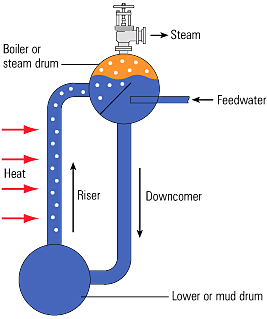Some of the important
boiler-efficiency deciding factors are explained in brief below:
Stack Temperature
It
is also referred to as flue gas temperature. It is defined as the
temperature level at which the hot exhaust gases make their way out of
the boiler. The flue gas temperature must be a proven value for the
efficiency calculation to be reflective of the true fuel usage of the
boiler. Lower than real stack temperature values must always be used for
boiler efficiency calculations.
Fuel Specification
The
specification of a fuel source can immensely affect the efficiency of a
boiler system. For example, if the hydrogen content within a gaseous
fuel source is comparatively high, extra water vapors get generated in
the burning process. These water vapors tend to consume heat energy from
the boiler for shifting their physical state during combustion. The
efficiency of the boiler generally drops if huge loss of water vapors
takes place. Due to this, the fuel oil offers greater boiler efficiency
as compared to natural gas. To get an accurate efficiency calculation, a
fuel specification that represents the jobsite fuel to be fired must be
used.
Excess Air
Excess
air is defined as the amount of surplus air provided to the burner
which is more than the necessary air needed to carry out combustion
process. This given excess air mainly acts as a safety air reservoir for
combustion in difficult situations such as inadequate air conditions.
However,
at the same time, this more than required air tends to consume heat
energy produced by combustion which in turn affects the heating
efficiency of the boiler. Seasonal changes in temperature and barometric
pressure can cause the excess air in a boiler to fluctuate 5% - 10%. A
realistic excess air level for a boiler in operation is 15% if an
appropriate safety factor is to be maintained.
Ambient Temperature
The
efficiency of a boiler also depends upon the ambient air temperature
surrounding the boiler. For every 40 degree shift in ambient
temperature, the efficiency of a boiler can get affected by at least 1%.
Since all the boiler rooms are maintained at moderately warm
temperature, majority of the efficiency computations takes upon 80 deg. F
as the ambient temperature value.
Radiation & Convection Losses
These
are the losses which emerge due to radiation of heat energy from the
boiler. To eliminate the effect of these losses, boiler systems are
usually shielded with some sort of insulation material. The presence of
these losses extremely influences the efficiency of a boiler. In cases
where these losses are not taken into consideration while performing
efficiency calculations, accurate fuel consumption value can never be
attained.
A boiler must always be designed in such a way that the
radiation and convection losses get minimized. These losses tend to
increase in proportion to the wind or air velocity prevailing around the
boiler. Hence, the boiler systems located in open atmosphere experience
more radiation and convection losses as compared to room boilers.
